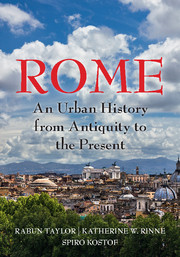Book contents
- Frontmatter
- Dedication
- Epigraph
- Contents
- List of Illustrations
- Acknowledgments
- Map
- INTRODUCTION
- 1 A BEND IN THE RIVER
- 2 A STORYBOOK BEGINNING
- 3 IDEOLOGICAL CROSSFIRE
- 4 BIG MEN ON THE CAMPUS
- 5 RES PUBLICA RESTITUTA
- 6 MEMORIALS IN MOTION: SPECTACLE IN THE CITY
- 7 THE CONCRETE STYLE
- 8 REMAKING ROME'S PUBLIC CORE: I
- 9 REMAKING ROME'S PUBLIC CORE: II
- 10 CRISIS AND CONTINUITY
- 11 RUS IN URBE: A GARDEN CITY
- 12 ADMINISTRATION, INFRASTRUCTURE, AND DISPOSAL OF THE DEAD
- 13 MAPPING, ZONING, AND SEQUESTRATION
- 14 TETRARCHIC AND CONSTANTINIAN ROME
- 15 TROPHIES AND TITULI: CHRISTIAN INFRASTRUCTURE BEFORE CONSTANTINE
- 16 WALLS MAKE CHRISTIANS: FROM FOURTH TO FIFTH CENTURY
- 17 A TALE OF TWO ROMES
- 18 THE ROME OF GOTHS AND BYZANTINES
- 19 CHRISTIAN FOUNDATIONS
- 20 FROM DOMUS LATERANI TO ROMANUM PALATIUM
- 21 THE LEONINE CITY: ST. PETER'S AND THE BORGO
- 22 VIA PAPALIS, THE CHRISTIAN DECUMANUS
- 23 THE URBAN THEATERS OF IMPERIUM AND SPQR
- 24 HOUSING DAILY LIFE
- 25 CHAOS IN THE FORTIFIED CITY
- 26 THE TIBER RIVER
- 27 HUMANIST ROME, ABSOLUTIST ROME (1420–1527)
- 28 PLANNING COUNTER REFORMATION ROME
- 29 PROCESSIONS AND POPULATIONS
- 30 MAGNIFICENT PALACES AND RHETORICAL CHURCHES
- 31 NEOCLASSICAL ROME
- 32 PICTURING ROME
- 33 REVOLUTION AND RISORGIMENTO
- 34 ITALIAN NATIONALISM AND ROMANITÀ
- 35 A CITY TURNED INSIDE OUT
- Glossary of Persons, Places, and Terms
- Works Cited
- Index
12 - ADMINISTRATION, INFRASTRUCTURE, AND DISPOSAL OF THE DEAD
Published online by Cambridge University Press: 05 July 2016
- Frontmatter
- Dedication
- Epigraph
- Contents
- List of Illustrations
- Acknowledgments
- Map
- INTRODUCTION
- 1 A BEND IN THE RIVER
- 2 A STORYBOOK BEGINNING
- 3 IDEOLOGICAL CROSSFIRE
- 4 BIG MEN ON THE CAMPUS
- 5 RES PUBLICA RESTITUTA
- 6 MEMORIALS IN MOTION: SPECTACLE IN THE CITY
- 7 THE CONCRETE STYLE
- 8 REMAKING ROME'S PUBLIC CORE: I
- 9 REMAKING ROME'S PUBLIC CORE: II
- 10 CRISIS AND CONTINUITY
- 11 RUS IN URBE: A GARDEN CITY
- 12 ADMINISTRATION, INFRASTRUCTURE, AND DISPOSAL OF THE DEAD
- 13 MAPPING, ZONING, AND SEQUESTRATION
- 14 TETRARCHIC AND CONSTANTINIAN ROME
- 15 TROPHIES AND TITULI: CHRISTIAN INFRASTRUCTURE BEFORE CONSTANTINE
- 16 WALLS MAKE CHRISTIANS: FROM FOURTH TO FIFTH CENTURY
- 17 A TALE OF TWO ROMES
- 18 THE ROME OF GOTHS AND BYZANTINES
- 19 CHRISTIAN FOUNDATIONS
- 20 FROM DOMUS LATERANI TO ROMANUM PALATIUM
- 21 THE LEONINE CITY: ST. PETER'S AND THE BORGO
- 22 VIA PAPALIS, THE CHRISTIAN DECUMANUS
- 23 THE URBAN THEATERS OF IMPERIUM AND SPQR
- 24 HOUSING DAILY LIFE
- 25 CHAOS IN THE FORTIFIED CITY
- 26 THE TIBER RIVER
- 27 HUMANIST ROME, ABSOLUTIST ROME (1420–1527)
- 28 PLANNING COUNTER REFORMATION ROME
- 29 PROCESSIONS AND POPULATIONS
- 30 MAGNIFICENT PALACES AND RHETORICAL CHURCHES
- 31 NEOCLASSICAL ROME
- 32 PICTURING ROME
- 33 REVOLUTION AND RISORGIMENTO
- 34 ITALIAN NATIONALISM AND ROMANITÀ
- 35 A CITY TURNED INSIDE OUT
- Glossary of Persons, Places, and Terms
- Works Cited
- Index
Summary
LET US PAUSE TO PONDER THE REMOTENESS OF ANCIENT ROME FROM OUR own urban experience. In the imperial period it was a city of unprecedented scale and complexity supporting about a million people. It had an incomparable infrastructure of roads, aqueducts, and sewers. Its supply systems and administrative apparatus were the most sophisticated in the ancient world. But if we contemplate the ancient city from our own urban experience, we see that it had no mayor, city council, or city hall; no urban planning commission; no sanitation department or public health service; no hospitals, public schools, or public transportation; no homeless shelters; no police crime units to prevent or investigate wrongdoing; and no prisons. (The famous carcer was merely a holding cell for condemned political prisoners.)
During the republic, Rome relied heavily on its citizenry to maintain infrastructure, uphold public order, and provide social amenities according to a patchwork code of laws and expectations. Outside this limited domain of private duty or initiative, the task of improving or maintaining the city fell mainly to the censors and the aediles, elected short-term magistrates whose most fundamental duty was to oversee public morals. Often the two censors undertook major public building and infrastructure projects of a nonsacred nature, while the two (later four) aediles saw to the city's maintenance, the proper execution of games, and the enforcement of personal modesty and restraint in public building. Their role was genuinely practical but also symbolic; the state of the urbs reflected their personal moral standing. The aedileship retained this signification long after the censorship lapsed, as was demonstrated when the emperor Caligula, observing that some streets of Rome were unswept, ordered mud to be thrown onto the toga of Vespasian, who was an aedile at the time.
Prodded by various crises, Rome did develop a robust professional bureaucracy in the high empire, some of it publicly and some imperially financed. In one unique case, the water commission's staff was divided between 240 public and 460 imperial slaves, the latter contingent added by Claudius. The city kept extensive records in a variety of locales: maps of publicly owned property at the Atrium Libertatis, death records at the grove of Venus Libitina, imperial procuratorial archives at the Horrea Piperataria (those incinerated in 192), etc.
- Type
- Chapter
- Information
- RomeAn Urban History from Antiquity to the Present, pp. 114 - 121Publisher: Cambridge University PressPrint publication year: 2016



